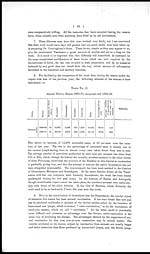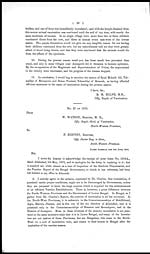Medicine - Vaccination > 1866-1901 - Annual report upon vaccination in the North-Western Provinces > Vaccination North-Western Provinces 1866-1877 > 1869-1870 - North-Western Provinces. Returns of vaccination for the season of 1869-70
(33) Page 17
Download files
Individual page:
Thumbnail gallery: Grid view | List view

( 17 )
toms are also a little more marked. For these reasons it is urged that the protection
afforded to the system is more complete than that given by ordinary vaccination. This
question is now, and must for several years remain, sub judice. As the number of
inoculations which may at one time be made on a single heifer is nearly unlimited, the
quantity of cow-pox matter produced is very considerable. On the outbreak of small-
pox epidemics this might be taken advantage of; for, by sending one or more inocu-
lated heifers into the infected locality a supply of fresh cow-pox lymph would be
given sufficient to vaccinate at once all the unprotected in the vicinity. Again, to such
people as believe that syphilis is communicable by vaccine lymph, animal vaccination
gives a protection against their fears; for, as far as experiments go, that disease is not
inoculable upon bovine animals. On the other hand, in addition to needless expense
and trouble, the opponents of animal vaccination shew that the percentage of success
from it falls far short of that attainable by arm-to-arm vaccination. The rapid passage
of the eruption through the active stage is also given as an objection. Dr. Seaton in
his work on Vaccination says : " There is no one in England whose opinion on this
subject will be received with so much respect as Mr. Ceely's, because there is no one
who has nearly the knowledge he possesses of the disease in the cow and its transplan-
tation into the human species. He looks upon this proceeding as not only open to the
objections of impracticability as applied to the general population and of unsuccess;
but he says that, so far from being likely to produce fewer ailments and cutaneous
eruptions in the pre-disposed, he knows from his experience that it would, as being
more irritating, produce more. He regards it as uncalled for either for regenerating
lymph or preventing syphilis." Notwithstanding the opinion of this high authority,
animal vaccination has, for some time, been gaining ground in England. It was lately
suggested that, as the Hindoos of this district were so much opposed to arm-to-arm
vaccination, they might more readily accept it if the lymph was taken direct from the
sacred cow. When Dr. Pearson heard of my intention of commencing animal vacci-
nation in Benares he recommended me not to begin in the cities either of Mirzapore or
Benares, but to select some thinly populated rural spot, as he was apprehensive of the
Hindoos imagining that blood would be taken from the cow. This opinion agreed
with that of almost all the educated Hindoos whom I consulted. On explaining the
process and the advantages which I hoped to derive from it to my Native Superinten-
dents and Vaccinators, they also were averse to its introduction, alleging that their
work would be stopped, and reminded me that all the more successful Vaccinators in
their intercourse with uneducated Hindoos refrain from mentioning the cow as the
original source of lymph, and call the vaccine matter simply " dawai" or "pani."
Having selected Hatta, a small village in the Goruckpore District, I purchased a couple
of healthy young heifers, and, with the assistance of a Brahmin Vaccinator and Native
Superintendent, vaccinated both of them in many places, partly from English and partly
from Indian virus. A few on-lookers, to whom also I had explained the process and
its advantages, watched proceedings until I began to use lancet and needle, when they
sullenly departed, ominously shaking their heads. Forthwith, all the children who had
been playing about the camping ground were recalled by their parents, nor was a child
to be seen during the following day while my camp remained there. On the sixth
day, when the vesicles on the heifers were ripe, I arrived at Khulelabad and after long
persuasion succeeded in vaccinating direct from one of them the child of a "bun-
neah" and two children belonging to the " teli " of the village. Two more heifers were
then vaccinated, and, as it was impossible to get any more of the villagers to consent to
their children being vaccinated direct from the former heifers, the remainder of the
lymph was collected on vaccine points and distributed to different Vaccinators. At
Tirkolia the same opposition was experienced, and but two children were vaccinated
direct from the second couple of heifers, the greater part of the virus being again col-
lected on points and distributed. Here not one of the villagers would on any condi-
tion sell me any of their cattle, and on the two following days my Native Superinten-
dent and the local Vaccinator failed both at Domeriagunge and Bhanpore in inducing
any of the people to part with their cows. At Ahma, I succeeded in purchasing three
1 5
Set display mode to: Large image | Zoom image | Transcription
Images and transcriptions on this page, including medium image downloads, may be used under the Creative Commons Attribution 4.0 International Licence unless otherwise stated. ![]()
| Permanent URL | https://digital.nls.uk/87224178 |
|---|
| Attribution and copyright: |
|
|---|




